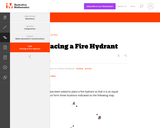
In this activity, students will use GeoGebra to construct using technology the circumcenter, incenter, centroid and orthocenter of triangles.
- Subject:
- Mathematics
- Material Type:
- Activity/Lab
- Date Added:
- 04/21/2018

In this activity, students will use GeoGebra to construct using technology the circumcenter, incenter, centroid and orthocenter of triangles.

This is a high school geometry task that has students physically construct the point equidistant from three non-collinear points and to identify why the construction works. This construction motivates the notion of a triangle inscribed into a circle and why that particular construction might be useful.
This task is a procedures with connections task, of high cognitive demand. The procedure is not specified for students but there is largely only one way of folding the paper to be able to identify the intersection point. The high cognitive demand comes from students having to explain why the construction works and why only two creases are necessary. This gets at both the meaning and motivation for the construction and the notion of efficiency in having a canonical construction for a circle that inscribes a triangle given three non-collinear points that can form a triangle.
This task could also be used as an assessment task after students learn the construction, although the explanations that may be given by students are more likely to focus on the construction procedures in this particular case.
This task addresses the Pivotal Understanding of equivalence, because it focuses on generating a geometric construction procedure that determines a point equidistant from three non-collinear points. Equivalence is evident in at least two ways. First, the distance from the target point to each of the source points is equal. Second, the construction produces equivalent results (inscribed triangle within a circle given three points) each time.

This video is meant to be a fun, hands-on session that gets students to think hard about how machines work. It teaches them the connection between the geometry that they study and the kinematics that engineers use -- explaining that kinematics is simply geometry in motion. In this lesson, geometry will be used in a way that students are not used to. Materials necessary for the hands-on activities include two options: pegboard, nails/screws and a small saw; or colored construction paper, thumbtacks and scissors. Some in-class activities for the breaks between the video segments include: exploring the role of geometry in a slider-crank mechanism; determining at which point to locate a joint or bearing in a mechanism; recognizing useful mechanisms in the students' communities that employ the same guided motion they have been studying.